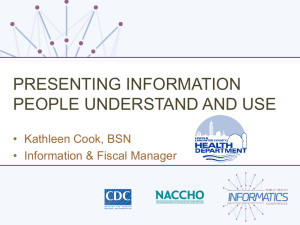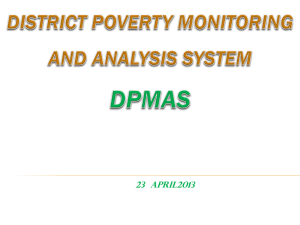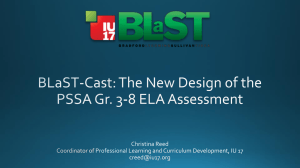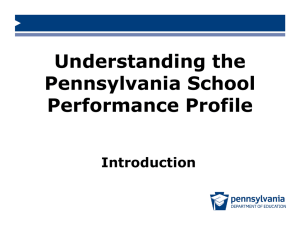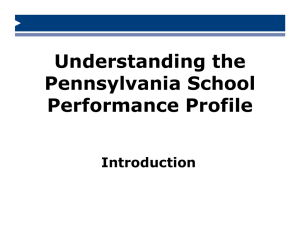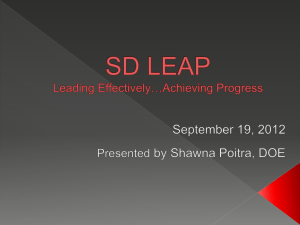Measurement
advertisement
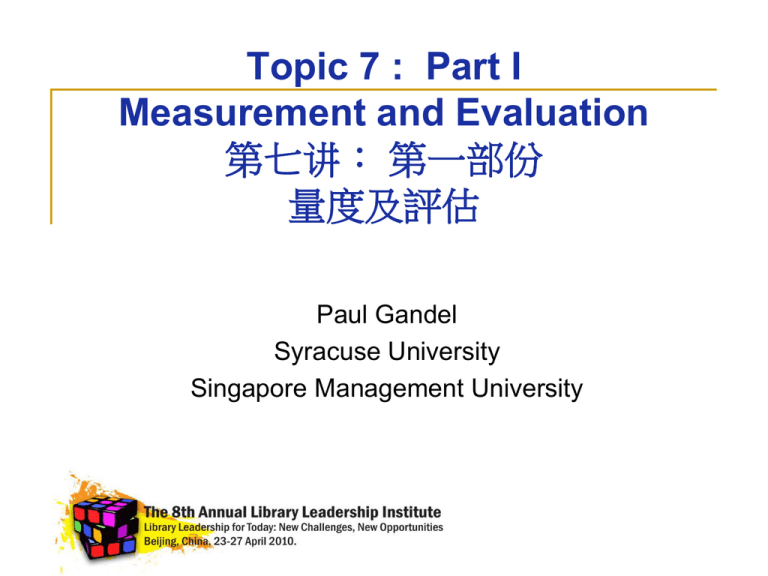
Topic 7 : Part I Measurement and Evaluation 第七讲: 第一部份 量度及評估 Paul Gandel Syracuse University Singapore Management University Methods to Measure and Display Outcomes 量度方法及展示结果 2 Basics of Measurement and Evaluation 量度及评估的基本因素 Defining measurement and evaluation 为量度及评估下定义 Frameworks for measurement 量度架构 Outcomes-based evaluation 基于结果的评估 Balance scorecard approach 平衡计分卡法 3 Why Measure? 为何要量度? Reference point 参考点 Where service was in the past 过往的服务 Current situation 目前的景况 Future trends 未来的趋势 Informs 报告 Decision makers 决策者 Managers 经理 Staff 员工 Sets Priorities 设定优次序 4 Problem 问题 Not too little data 数据量不宜太少 NOT THE RIGHT DATA! 不是正确的数据! 5 Measurement vs. Evaluation 量度與评估 Measurement is collecting the raw numbers 量度是收集原始数目 Evaluation is the determination of the value of the service 评估是决定服务的价 值 Evaluation requires a perspective 评估需要一套正确的 方法 Creating indicators allows for incorporating some context 设定指标时容许加入 某些内容 6 Measurement Framework 量度架构 From Joseph Mathews Measuring for Results 7 Measurement Framework量度架构 F e e d b a c k Resources 资源 Capability 能力 Input Measures 投入量度 Process Measures 过程量度 Quality 质量 Demand Utilization 效用 Impact & Effect 影响及效果 Output Measures 產出量度 Outcomes Value 结果 价值 8 Input Measures 投入量度 Measure the capacity/potential Easy to collect and report Examples: 量度能力或潜力 容易收集及报告 范例: Income/Expenditures Staffing Collection (total, growth, 收入/ 支出 recency) Infrastructure (cost, speed, space, number of workstations, etc.) User base statistics 近购买的) 基础设施(成本,速度, 空间,工作间数目等) 基于用户的统计 人力资源 馆藏 (总数,增长,最 9 Process/Efficiency Measures 过程 / 效率量度 Are we doing things correctly? 我们是否做得正确? Efficiency—how economical is an activity? Cost per transaction for reference service, document delivery, etc. Productivity—focus on time to complete task or activity. Time to catalog an item, time to process a transaction, etc. System Reliability—focus on percent of uptime or availability of the system 效率 ─ 活动是否够经济? 每项咨询参考及文献送 递等服务的成本 生产力 ─ 着眼于完成任 务或活动的时间。将一 项馆藏分类的时间,处 理一项服务的时间。 系统可靠性 ─ 着眼于正 常运作时间的百分比或 系统可用性 10 Output Measures 产出量度 Looks at the use of the Library or a particular service 考虑图书馆或某项专门 服务的用量 Services. Counts and use per capita statistics. Annual circulation, attendance, etc 服务。以人均统计方法 计算。书籍流通量,出 席率等。 Quality—what was provided and how was it provided. Lead to measures of satisfaction and value. 质量 ─ 有何服务及如何 提供該服务。带出满意 度及价值的量度。 11 Satisfaction Measures 满意度量度 Blanket question = useless information 一般的问题= 没用的信息 Ask about specific components of the experience 询问某经验的特别部分 Ask about how the user is doing not just how the service is doing 询问用户的感受如何,而 不单只是询问服务如何 Ask about expectations (LIBQUAL) 了解期望(LIBQUAL) Ask about importance—was this service important to the user? 询问重要性 ─ 该项服务 对用户是否重要? 12 Priority and Performance 优先次序及表現 What priority should the library give to the following? How important? 图书馆如何为以下项目定 优先次序? 有多重要? How well does the library perform the following services or functions? 图书馆在以下服务或功能 表现如何? Usually use a 7 point Likert scale 通常用 Likert 的 7 级分表 13 Success Metrics: Purpose 成功规范:目的 • To establish clear accountability and clarity of purpose – Both measured group and the group for whom measures are collected are clearly stated • To create focus and alignment • 设立清晰的责任和明确的 目的 – 明确定义被量度的小组及征 用资料的小组 • 重点设定及调整 – The measures collected are in line with the mission, goals, vision, and values of the library – 收集的数据应与图书馆的使 命、目标、愿景及价值配合 14 Partially from Matthews, J. (2004) Measuring for Results: The Dimensions of Public Library Effectiveness Success Metrics: Purpose 成功规范:目的 • 容许持续改善 • To enable continuous refinement – Measures are reviewed and changed to keep up with changes in environment • To provide rigorous indicators – 检讨及改变数据以配合环 境转变 • 提供严密的指标 – Measures are well-defined using unambiguous language and with as little bias as possible – 量度指标应用不含糊的语 言作严格的定义以尽量减 少偏见 15 Partially from Matthews, J. (2004) Measuring for Results: The Dimensions of Public Library Effectiveness Balancing Success Metrics 平衡成功规范 • Absolute versus relative measures – Comparisons add context (but are not always appropriate) • Objective versus subjective – How much does background of evaluator affect the interpretation of the results? • Outcomes over process – Focus on outcomes, not on the process • Performance versus diagnostic – Measure achievements and discover problematic areas • Peer institution benchmarks versus best practice • 絶对指标与相对指标 – Comparisons add context (但并不总是适合) • 客观与主观 – 评估人的背景对结果的演绎影 响有多深 • 结果与过程 – 侧重于结果而非过程 Partially from Matthews, J. (2004) Measuring for Results • 表现及诊断法 – 量度成就及发现有问题的地方 • 同水平学院的标准与优良惯例 16 Types of Performance Indicators 表现指标 • Direct versus indirect indicators – Measuring a specific activity vs. measuring a surrogate for an activity (looking at citations as surrogate for measuring value of materials) • Lagging versus leading indicators – Lagging = actual performance, while leading = prediction of something else • Social versus economic indicators – Measures indicative of the impact of the library on a community as compared to the economic importance (and cost) of the library • 直接与间接指标 – 量度一项特定的活动与量度一 项相关的活动 (考虑以引用次数 作为量度实际价值的相关指标) • 落后的与领先的指标 – 落后 =实际表现,而领先 =其他 预测 • 社会指标与经济指标 – 此量度方法表示出与图书馆的 经济重要性(及成本)相比图书馆 对社会的影响 17 From Matthews, J. (2004) Measuring for Results: The Dimensions of Public Library Effectiveness Balanced Scorecard Approach 平衡計分卡 • • • • • User perspective – How do users perceive the library? Is that perspective changing? Internal perspective – In which services should the library aim to excel? Information resources perspective – What should be in the library collections? Innovation perspective – How can the library continue to develop new services? Financial perspective – How can the library demonstrate the best value for the money invested by the institution in the library? • 用户观感 – 用户对图书馆有何观感? 他们 的观感是否在转变? • 内部认知 – 图书馆应着意突出哪几项服务? • 资源概念 – 图书馆藏应包含甚么? • 创新观念 – 图书馆如何继续新服务? • 财务视角 – 图书馆如何展示学院对图书馆 的投资物有所值? 18 Based upon: Matthews, J. (2004) Measuring for Results: The Dimensions of Public Library Effectiveness Balanced Scorecard 平衡计分卡 Library Perspective 以图书馆为例 Mission 使命 Financial Perspective 财务构面 Information Resources Perspective 资源构面 Customer Perspective 顾客构面 Process Perspective 流程构面 19 Organizational Dashboards 组织仪表盘 容易使用的表现展示工具 User-friendly tool to display performance 有效及有意义的进度追踪 Effective and meaningful way to 方法 track progress View results: efficiency, 看得见的结果:效率、效 effectiveness, and impact 力及影响 Should integrate into the 将图书馆整体表现的某些 strategic plan a limited number of 关键指标纳入策略规划 critical indicators of overall library 各部门可有自己的仪表 performance 盘 Departments may have their own dashboards Source: Butler, L. The Nonprofit Dashboard: A Tool for Tracking Progress (BoardSource, 2007) 20 Organizational Dashboards / 组织仪表盘 What to measure? Outcomes Mission as spine Strategic initiatives Drivers of success Risk factors Service/resource matrix 量度甚么? 结果 使命是支持因素 策略上的主动权 成功动力 冒险因素 服务/资源矩阵 How to track and display? Combine statistics with visual indicators Graphs and 如何追踪及展示 将统计数字与看 得见的指标结合 图形及图表 Source: Butler, L. The Nonprofit Dashboard: A Tool for Tracking Progress (BoardSource, 2007) 21 Relating the Mission to the Dashboard 将使命与仪表盘联系起来 Mission Statement /使命宣言 Purpose 目的 The library provides information … 图书馆提供信息… Audience 读者 for faculty and students of the university … 为大学学系及学生 Methods 方式 through electronic and print resources … 透过电子及印刷资源 Outcomes 结果 to enable our clients to meet their research and learning needs 以令顾客满足教研需要 Performance Indicators / 表现指标 Number of searches performed using eresources 电子资源的搜寻次数 Use of facilities for Involvement of faculty research, group and and students individual study, presenting their determined through research results based random counts upon library resources 以随机数确定为研究, 学系及学生参与介绍 小组与个人学习而建 以图书馆资源为基础的 的设备的运用 研究成果 Adapted from: Butler, L. The Nonprofit Dashboard: A Tool for Tracking Progress (BoardSource, 2007) Client responses re: lessons learned and quality of research or learning enhanced by library 顾客就习得经验及图书 馆对教研质量提升的回 馈反应 22 Final Step: The Reality Check! 最後的步驟:實際檢驗 23 Developing measures — Class Exercise 设定量度方法 ─ 小组研习 Start with a topic area of the library service 以图书馆服务为一专题 开始 Think about different parts of that library services and operations 考虑图书馆服务的不同 部分及运作 Objectives, Inputs, Output, Efficiency, Quality, Immediate Outcomes, Long-Term Outcomes Consider what could be measured about each part of the process, considering the balances just discussed 目标,投入,产出,效 率,质量,实时结果, 长远结果 考虑过程的每一部分需 量度甚么,考虑之前讨 论过的平衡 From Matthews, J. (2004) Measuring for Results: The Dimensions of Public Library Effectiveness 24

